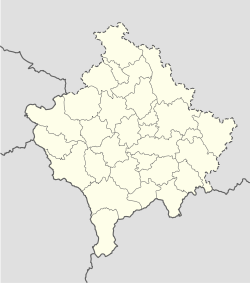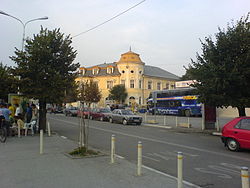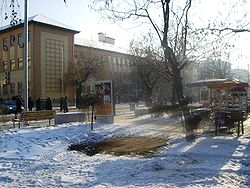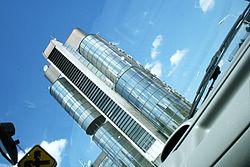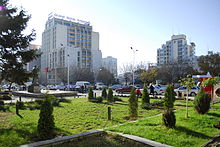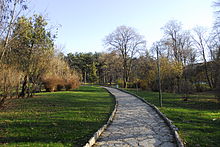- Pristina
-
"Prishtina" redirects here. For the Albanian politician, see Hasan Prishtina.
Pristina — Municipality and City — Pristina
Prishtina / Prishtinë
Приштина / PrištinaLocation in Kosovo Coordinates: 42°40′N 21°10′E / 42.667°N 21.167°E Country Kosovo[1] District District of Pristina Area – Total 854 km2 (329.7 sq mi) Elevation 652 m (2,139 ft) Population (2011) – Total 198,214 – Density 232.1/km2 (601.1/sq mi) Time zone CET (UTC+1) – Summer (DST) CEST (UTC+2) Area code(s) +381 38 Website Municipality of Pristina (Albanian) Pristina, also spelled Prishtina
 listen (help·info) and Priština (Albanian: Prishtinë or Prishtina, Serbian: Приштина or Priština; Turkish: Priştine) is the capital and largest city of Kosovo.[1] It is the administrative centre of the homonymous municipality and district.
listen (help·info) and Priština (Albanian: Prishtinë or Prishtina, Serbian: Приштина or Priština; Turkish: Priştine) is the capital and largest city of Kosovo.[1] It is the administrative centre of the homonymous municipality and district.Preliminary results of 2011 census puts population of Pristina at 200,000.[2] The city has a majority Albanian population, alongside other smaller communities including Bosniaks, Roma and others. It is the administrative, educational, and cultural centre of Kosovo. The city is home to the University of Pristina and is served by the Pristina International Airport.
Contents
Name
The name of the city is derived from a Slavic form *Prišьčь, a possessive adjective from the personal name *Prišьkъ, (preserved in the Kajkavian surname Prišek, in the Old Polish personal name Przyszek, and in the Polish surname Przyszek) and the derivational suffix -ina 'belonging to X and his kin'.[citation needed] The name is most likely a patronymic of the personal name *Prišь, preserved as a surname in Polish Przysz and Sorbian Priš, a hypocoristic of the Slavic personal name Pribyslavъ.[3] A false etymology[citation needed] connects the name Priština with Serbo-Croatian prišt (пришт), meaning 'ulcer' or 'tumour', referring to its 'boiling'.[4] However, this explanation cannot be correct, as Slavic place names ending in -ina corresponding to an adjective and/or name of an inhabitant lacking this suffix are built from personal names or denote a person and never derive, under these conditions, from common nouns (SNOJ 2007: loc. cit.). The inhabitants of this city call themselves Prishtinali in local Gheg Albanian or Prištevci (Приштевци) in the local Serbian dialect.
Geography
Pristina is located at the geographical coordinates 42° 40' 0" North and 21° 10' 0" East and covers 572 square kilometres (221 sq mi). It lies in the north-eastern part of Kosovo close to the Goljak mountains. From Pristina there is a good view of the Šar Mountains which lie several kilometres away in the south of Kosovo. Pristina is located beside two large towns, Obilić and Kosovo Polje. In fact Pristina has grown so much these past years that it has connected with Kosovo Polje. Lake Badovac is just a few kilometres to the south of the city.
There is no river passing through the city of Pristina now but there was one that passed through the centre. The river flows through underground tunnels and is let out into the surface when it passes the city. The reason for covering the river was because the river passed by the local market and everyone dumped their waste there. This caused an awful smell and the river had to be covered.[citation needed]
The river now only flows through Pristina's suburbs in the north and in the south.
Climate
Pristina has a humid continental climate with very warm summers and cold and often snowy winters.
Climate data for Pristina Month Jan Feb Mar Apr May Jun Jul Aug Sep Oct Nov Dec Year Average high °C (°F) 3
(37)6
(43)11
(52)15
(59)21
(70)25
(77)27
(81)28
(82)22
(72)17
(63)10
(50)4
(39)15.8
(60.4)Average low °C (°F) −5
(23)−3
(27)0
(32)4
(39)9
(48)12
(54)14
(57)14
(57)10
(50)6
(43)1
(34)−3
(27)4.9
(40.9)Avg. rainy days 6 4 7 13 13 8 7 7 8 8 9 7 97 Source: Weather2 [5] Panorama
History
Early history
In Roman times, a large town called Ulpiana existed 15 kilometers (9.3 mi) to the south of modern-day Pristina. This city was destroyed but was restored by the Emperor Justinian I. Today the town of Lipljan stands on the site of the Roman city, and remains of the old city can still be seen.
After the fall of Rome, Pristina grew from the ruins of the former Roman city. The city was located at a junction of roads leading in all directions throughout the Balkans. For this reason Pristina rose to become an important trading centre on the main trade routes across south-eastern Europe.
Pristina came to be of great importance to the medieval Serbian state, and served as the capital of King Milutin (1282–1321) and other Serbian rulers from the Nemanjić and Branković dynasties until the Battle of Kosovo in 1389, when an invading Ottoman army decisively defeated the Balkans coalition army. In the following decades the area gradually came under Ottoman control, there was an Ottoman law-court in Pristina in 1423. The whole of Serbia was subsequently conquered by the Ottoman Empire in 1459.
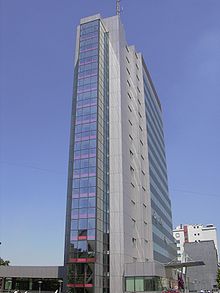 Kosovar Government Central Building (Formerly a bank, damaged in the 1999 war, now fully renovated)
Kosovar Government Central Building (Formerly a bank, damaged in the 1999 war, now fully renovated)
Pjeter Bogdani, who is the most original writer of early literature in Albanian, lived and worked in Kosovo. After his return to the Balkans in March 1686 and spent the next years promoting resistance to the armies of the Ottoman Empire, in particular in Kosovo. In 1686 Pristina was briefly liberated by Pjeter Bogdani with aid of Austrians. He published his book Cuneus Profetarum (Alb: Ceta e Profeteve roughly Vanguard of the Prophets) in 1685.[6] At the same time, simultaneously with the Ottoman conquest, the Great Serb exodus has started; tens of thousands of Kosovo Serb families have withdrawn from Kosovo towards Habsburg Empire, led by their patriarch Arsenije III Carnojevic, along with the Habsburg army.[7][7] Demographic balanced slowly started to shift in favour of Albanians.[8]
During the Ottoman Empire, Pristina became increasingly Ottoman in character following the conversion to Islam of many of its inhabitants, both Albanians and Slavs.
From the 1870s onwards Albanians in the region formed the League of Prizren to resist Ottoman rule, and a provisional government was formed in 1881. In 1912 Pristina along with the rest of Kosovo was briefly included in the newly independent state of Albania. But the following year the Great Powers forced Albania to cede the region to the Kingdom of Serbia. In 1918 Kosovo became a part of the newly formed Yugoslavia, though without any of the autonomy that the region later enjoyed.
Before World War II, Pristina was an ethnically mixed town with large communities of Albanians and Serbs. However, a mass series of both ethnic cleansing and genocide perpetrated by ethnic Albanians backed by the Nazis swung this largely in the Albanian's favour.[9][10]
Before the 1999 war over 25,000 Serbs lived in Pristina, as a result of a post war ethnic cleansing, there is anything from several dozen to several thousand.
Balkan Wars
After the Serbian army took the city of Pristina in October 1912, the retaliation against the civilian population was fierce.[11] Reports say that immediately upon entering the city, the Serbian army began "hunting" the Albanians, making bloodshed and "literally decimated" Pristina population.[12]
Number of Albanians of Pristina killed in the early days of the Serbian rule is estimated at 5,000.[11][13]
World War II
The Second World War saw the decline of Pristina's Serbian community as well as a large-scale settling of Albanians in the town. Between 1941 and 1945 Pristina was incorporated into the Italian-occupied Greater Albania.
Pristina after World War II
In 1946, Pristina became the capital of the Socialist Autonomous Region of Kosovo. Between 1953 and 1999, the population increased from around 24,000 to over 300,000. All of the national communities of the city increased over this period, but the greatest increase was among the Albanian population, a large number of whom had moved from mountain areas to settle in the city. The Albanian population increased from around 9,000 in 1953 to nearly 76,000 in 1981. The Serbian and Montenegrin population increased too but by a far more modest number, from just under 8,000 in 1953 to around 21,000 by 1981. By the start of the 1980s, Albanians constituted over 70% of the city's population.
Although Kosovo was under the rule of local Albanian members of the Communist Party, economic decline and political instability in the late 1960s and at the start of the 1980s led to outbreaks of nationalist unrest. In November 1968, student demonstrations and riots in Belgrade spread to Pristina, but were put down by the Yugoslav security forces. Some of the demands of the students were nonetheless met by the Tito government, including the establishment in 1970 of the University of Pristina as an independent institution. This ended a long period when the institution had been run as an outpost of Belgrade University and gave a major boost to Albanian-language education and culture in Kosovo. The Albanians were also allowed to use the Albanian flag.
In March 1981, students at Pristina University rioted over poor food in their university canteen. This seemingly trivial dispute rapidly spread throughout Kosovo and took on the character of a national revolt, with massive popular demonstrations in Pristina and other Kosovo towns. The Communist Yugoslav presidency quelled the disturbances by sending in riot police and the army and proclaiming a state of emergency, with several people being killed in clashes and thousands subsequently being imprisoned or disciplined.
Pristina in the Kosovo War and afterwards
Following the reduction of Kosovo's autonomy by Serbian President Slobodan Milošević in 1989, a harshly repressive regime was imposed throughout Kosovo by the Serbian government with Albanians largely being purged from state industries and institutions.[citation needed] The University of Pristina was seen as a hotbed of Albanian nationalism and was duly purged: 800 lecturers were sacked and 22,500 of the 23,000 students expelled.[citation needed] In response, the Kosovo Albanians set up a "shadow government" under the authority of the Democratic League of Kosovo (LDK), led by the writer Ibrahim Rugova. Although the city was formally controlled by Serbs appointed by the Milošević government, the LDK established parallel structures, funded by private contributions, to provide free services such as health care and education that were largely denied to the Albanian population.
The LDK's role meant, that when the Kosovo Liberation Army began to attack Serbian and Yugoslav forces from 1996 onwards, Pristina remained largely calm until the outbreak of the Kosovo War in March 1999. The city was placed under a state of emergency at the end of March and large areas were sealed off.[citation needed] After NATO began air strikes against Yugoslavia on March 24, 1999, widespread violence broke out in Pristina. Serbian and Yugoslav forces shelled several districts and, in conjunction with paramilitaries, conducted large-scale expulsions of ethnic Albanians accompanied by widespread looting and destruction of Albanian properties. Many of those expelled were directed onto trains apparently brought to Pristina's main station for the express purpose of deporting them to the border of the Republic of Macedonia, where they were forced into exile. The United States Department of State estimated in May 1999 that between 100,000-120,000 people had been driven out of Pristina by government forces and paramilitaries.[citation needed]
On or about 1 April 1999, Serbian police went to the homes of Kosovo Albanians in the city of Pristina/Prishtinë and forced the residents to leave in a matter of minutes. During the course of these forced expulsions, a number of people were killed. Many of those forced from their homes went directly to the train station, while others sought shelter in nearby neighbourhoods. Hundreds of ethnic Albanians, guided by Serb police at all the intersections, gathered at the train station and then were loaded onto overcrowded trains or buses after a long wait where no food or water was provided. Those on the trains went as far as General Jankovic, a village near the Macedonian border. During the train ride many people had their identification papers taken from them.[14]
— War Crimes Indictment against Milosevic and others
Several strategic targets in Pristina were attacked by NATO during the war, but physical damage appears to have largely been restricted to a few specific neighbourhoods shelled by Yugoslav security forces. At the end of the war, most of the city's 40,000[15] Serbs fled. The few who remained were subjected to harassment and violence in revenge by Albanian gangs, which reduced Pristina's Serb population still further. Other national groups accused by Albanians of collaboration with the Serbian war effort; notably the Roma– were also driven out. According to the United Nations High Commissioner for Refugees, by August 1999 fewer than 2,000 Serbs were left in the city. The number reportedly fell even further after the March 2004 unrest in Kosovo.
Economy
The number of registered businesses in Pristina is currently at 8,725, with a total of 75,089 employees[citation needed]. The exact number of businesses is unknown because not all are registered. Since independence the Mayor of Pristina, Isa Mustafa has built many new roads in Pristina. Also he has plans to construct a ring road around the city.[16] The national government is taking part in modernising the roadways as well, building motorways to Uroševac and other cities[citation needed]. An Albanian millionaire in Croatia is building the largest building in the Balkans with a projected height of up to 262 metres (860 ft) and capacity to hold 20,000 people. The cost for this is 400 million Euro.[17] The Lakriste area is designated by Municipality as high-rise area with many complex building. The buildings such as ENK, World Trade Centre, Hysi and AXIS towers are being constructed in an area which previously served as an industrial zone.[18]
Limak Holding and French firm Aéroport de Lyon won the concession tender for Pristina International Airport. Two companies pledged investment of 140 million euros by 2012.[19]
Places around Pristina
Name Description Picture New Born The Newborn Obelisk inaugurated for Kosovo's Independence on the 17/02/2008. 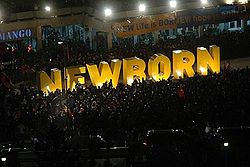
Rilindja Tower The building of the former "Rilindja" newspaper, also the tallest in Pristina. UNMIK Headquarters United Nations Interim Administration Mission in Kosovo Headquarters 
Mother Teresa Boulevard The Mother Teresa Boulevard. The Ministry of Culture The Ministry of Culture OSCE Building OSCE Building The museum of Kosovo The Kosovo Museum has an extensive collection of archaeological and ethnological artifacts, including the Neolithic Goddess on the Throne terracotta, unearthed near Pristina in 1960[20] 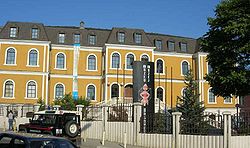
City Stadium Home to football club, KF Prishtina 
Culture
The Museum of Kosovo is located in an Austro-Hungarian inspired building originally built for the regional administration of the Ottoman Vilayet of Kosovo. From 1945 until 1975 it served as headquarters for the Yugoslav National Army. In 1963 it was sold to the Kosovo Museum. From 1999 until 2002, the European Agency for Reconstruction had its main office in the museum building.
The Kosovo Museum has an extensive collection of archaeological and ethnological artifacts, including the Neolithic Goddess on the Throne terracotta, unearthed near Pristina in 1960[20] and depicted in the city's emblem. Although a large number of artifacts from antiquity is still in Belgrade, even though the museum was looted in 1999.
The Clock Tower (Sahat Kulla) dates back to the 19th century. Following a fire, the tower has been reconstructed using bricks. The original bell was brought to Kosovo from Moldavia. It bore an inscription reading "this bell was made in 1764 for Jon Moldova Rumen." In 2001, the original bell was stolen. The same year, French KFOR troops replaced the old clock mechanism with an electric one. Given Kosovo's electricity problems the tower is struggling to keep time.
Environment
City Park was a badly managed, and was the only real green place in Pristina.[citation needed] Three markets (one of them very large) used to be a hotspot for dumping waste and other materials on the roads.[citation needed]
After the war of 1999, Pristina has changed dramatically.[citation needed] City Park has been fully changed.[citation needed] It now has stone pathways, tall trees, flowers have been planted and a public area has been built for children.[citation needed] The much larger Gërmia Park, located to the east of the city is the best place for a family to go and relax. Restaurants, small paths for people to have a run and a large outdoor swimming pool, basketball and volleyball court have been built for the pleasure of the citizens. Lately a new green place called Tauk Bashqe has been made half way between Gërmia and City Park.[citation needed]
After the construction of the new Mother Teresa Square, many trees and flowers have been planted. This had a big impact on the city because of the trees releasing oxygen in the air. Many old buildings in front of the government building have been cleared to provide open space.[citation needed]
Education
Universities
Sport
Basketball has been, since 2000, one of the most popular sports in Pristina. In this sport Pristina is represented in the Basketball National League by two teams. Streetball Kosova is a traditionally organized sport and cultural event in Germia Lake in Pristina, since Year 2000, too. Football is also very popular. Pristina's representatives KF Prishtina play their home games in the city's stadium.
Handball is also very popular. Pristina's representatives are recognised internationally and play international matches.
Demographics
Ottoman Empire
The Ottomans started conducting census surveys in Rumelia in 1486. Approximate populations reported were:
- 1486: 392 families
- 1487: 412 Christian households and 94 Muslim households
- 1569: 692 families
- 1669: 2,060 families
- 1685: 3,000 families
- 1689: 4,000 families
From 1850, surveys were conducted in the Vilayet of Kosovo. Populations reported were:
- 1850: 12,000 citizens, in 3,000 families
- 1902: 18,000 citizens, in 3,760 families
Serbia and Kingdom of Yugoslavia
- The 1921 official population census conducted by the Kingdom of Serbs, Croats and Slovenes listed 14,338 citizens.
- The 1931 official population census organised by the Kingdom of Yugoslavia listed 18,358 inhabitants by mother languages:
-
- Turkish - 7,573 (41%)
- Serbian - 5,738 (31%)
- Albanian - 2,351 (13%)
- other languages (Romani, Circassian etc.) - 2,651 (14%)
Socialist Yugoslavia
The 1948 official population census of the Autonomous Province of Kosovo and Metohija organised by the government of the People's Republic of Serbia under the Federal People's Republic of Yugoslavia government recorded 19,631 citizens in 4,667 families.
The 1953 official population census of the Autonomous Province of Kosovo and Metohija organised by the government of Serbia under the Yugoslav government recorded 24,229 citizens:
-
- 9,034 Albanians (37%)
- 7,951 Serbs and Montenegrins (33%)
- 4,726 Turks (20%)
- 2,518 Roma and others (10%)
The 1961 official population census of the Autonomous Province of Kosovo and Metohija organised by the government of the Socialist Republic of Serbia under the Socialist Federal Republic of Yugoslavia government recorded 38,593 citizens in 9,095 families:
-
- 19,060 Albanians (49%)
- 14,695 Serbs and Montenegrins (38%)
- 404 Croats (1%)
- 195 Roma
The 1971 official population census of the Socialist Autonomous Province of Kosovo organised by the government of the Socialist Republic of Serbia under the Socialist Federal Republic of Yugoslavia government 69,514 citizens in 14,813 families:
-
- 40,873 Albanians (59%)
- 19,767 Serbs and Montenegrins (28%)
- 4,119 Roma (6%)
The 1981 official population census of the Socialist Autonomous Province of Kosovo organised by the government of the Socialist Republic of Serbia under the Socialist Federal Republic of Yugoslavia government 108,083 citizens in 21,017 families:
-
- 75,803 Albanians (70%)
- 21,067 Serbs and Montenegrins (19%)
- 5,101 Roma (5%)
- 2,504 Muslims (2%)
According to the last census in 1991 (boycotted by the Albanian majority), the population of the Pristina municipality was 199,654, including 77.63% Albanians, 15.43% Serbs and Montenegrins, 1.72% Muslims by nationality, and others.[21] This census cannot be considered accurate as it is based on previous records and estimates.
In 2004 it was estimated that the population exceeded half a million, and that Albanians form around 98% of it. The Serbian population in the city has fallen significantly since 1999, many of the city's Serbs having fled or been expelled following the end of the war. In early 1999 Pristina had about 230,000 inhabitants. There were more than 40,000 Serbs and about 6,500 Romas with the remainder being Albanians.
Ethnic Composition, Including IDPs1 Year Albanians % Serbs % Roma % Others2 % Total 1991 census3 161,314 78.7 27,293 13.3 6,625 3.2 9,861 4.8 205,093 19984 N/A N/A N/A N/A N/A N/A N/A N/A 225,388 February 2000 estimate5 550,000 97.4 12,000 2.2 1,000 0.1 1,800 0.3 564,800 Source: OSCE Priština municipal profilePDF (511 KB), June 2006, page 2 (Table 1.1).
1. IDP: Internally displaced person.
2. Others include Montenegrins, Muslim Slavs, Turks, etc.
3. 1991 figures from Federal Republic of Yugoslavia (FRY) Institute for Statistics. It is noted that the 1991 census was highly politicised and is thus unreliable.
4. 1999 figures from UNHCR, "Kosovo Village List", 9 March 1999 (1998 population estimate excluding forced displacement).
5. 2001 figures from KFOR – MNB (c) and for minority figures OSCE/UNHCR ‘Situation of Ethnic Minorities in Kosovo’, February 2001.International relations
See also: List of twin towns and sister cities in KosovoTwin towns — Sister cities
Pristina is twinned with:
See also
- District of Pristina
- Kosovo War
- University of Pristina
- Bregu i Diellit
- Pristina City Stadium
- Pristina International Airport
References
- ^ a b Kosovo is the subject of a territorial dispute between the Republic of Serbia and the self-proclaimed Republic of Kosovo. The latter declared independence on 17 February 2008, while Serbia claims it as part of its own sovereign territory. Its independence is recognised by 85 UN member states.
- ^ "MOJE Vijesti | Vijesti | Region | Popis stanovnistva na Kosovu produzen do 19. aprila". Mojevijesti.ba. 2011-04-15. http://www.mojevijesti.ba/novost/79619/popis-stanovnistva-na-kosovu-produzen-do-19-aprila. Retrieved 2011-06-03.
- ^ SNOJ, Marko. 2007. Origjina e emrit të vendit Prishtinë. In: BOKSHI, Besim (ed.). Studime filologjike shqiptare: konferencë shkencore, 21-22 nëntor 2007. Prishtinë: Akademia e Shkencave dhe e Arteve e Kosovës, 2008, pp. 277-281.
- ^ This etymology is mentioned in ROOM, Adrian: Placenames of the World, Second Edition, McFarland, 2006, page 304. ISBN 0-7864-2248-3
- ^ "Climate profile for Pristina | Holiday and Travel". MyWeather2.com. http://www.myweather2.com/City-Town/Serbia-And-Montenegro/Pristina/climate-profile.aspx. Retrieved 2011-06-03.
- ^ "Pjetër Bogdani - Wikipedia, the free encyclopedia". En.wikipedia.org. http://en.wikipedia.org/wiki/Pjet%C3%ABr_Bogdani. Retrieved 2009-07-08.
- ^ a b Serbia: the history behind the name - Google Books. Books.google.com. http://books.google.com/books?id=0_3Wt46vBv8C&pg=PA20&lpg=PA20&dq=serb+migrations+emperor+leopold&source=bl&ots=9pUqtVbDhw&sig=ROm-TTMNu9bLWuN_8y9dSVFNwwE&hl=en&ei=zXxIS8TbFpyOnQPH8bWFCQ&sa=X&oi=book_result&ct=result&resnum=5&ved=0CBEQ6AEwBDgK#v=onepage&q&f=false. Retrieved 2011-06-03.
- ^ Silber, Laura. "Kosovo: A Short History (9780060977757): Noel Malcolm, University Pres New York: Books". Amazon.com. http://www.amazon.com/dp/0060977752. Retrieved 2011-06-03.
- ^ Dragutin Mladich. "Carl Kosta Savich: Albanian Skenderbeg SS Division". Guskova.ru. http://www.guskova.ru/~mladich/Kosmet/skenderbeg. Retrieved 2011-06-03.
- ^ "Skenderbey SS Division". Kosovo.net. http://www.kosovo.net/skenderbeyss.html. Retrieved 2011-06-03.
- ^ a b "Archbishop Lazër Mjeda: Report on the Serb Invasion of Kosova and Macedonia". Albanianhistory.net. http://www.albanianhistory.net/texts20_1/AH1913_6.html. Retrieved 2010-07-04.
- ^ "Leo Freundlich: Albania's Golgotha". Albanianhistory.net. http://www.albanianhistory.net/texts20_1/AH1913_1.html. Retrieved 2010-07-04.
- ^ "The New York Times, 31. December 1912". New York Times. 1912-12-31. http://query.nytimes.com/mem/archive-free/pdf?_r=2&res=9D0CEEDA1E3AE633A25752C3A9649D946396D6CF&oref=slogin. Retrieved 2010-07-04.
- ^ "Indictment against Milosevic and others". Americanradioworks.publicradio.org. http://americanradioworks.publicradio.org/features/kosovo/more2.htm. Retrieved 2010-07-04.
- ^ "EuroNews Serbs in Kosovo vote in Gracanica and Mitrovica published February 3, 2008 accessed February 3, 2008". Euronews.net. http://www.euronews.net/index.php?article=468126&lng=1&option=1. Retrieved 2010-07-04.
- ^ Komuna e Prishtinës: Investime të mëdha në infrastrukturë
- ^ Macedonia participates in large Kosovo investment
- ^ New Kosova Report: Record setting skyscraper to go up in Pristina
- ^ Todays Zaman: Kosovo to open to world with Turkish-built airport, by Ali Aslan Kiliç, 14 August 2010, Saturday
- ^ a b Kosovo contest for state symbols, by Nick Thorpe, BBC, Priština, 4 June 2007. Retrieved on 21 February 2008.
- ^ Statistic data for the municipality of Priština - grad[dead link]
- ^ "Turkey's Bursa, Kosovo's Pristina become sister cities" worldbulletin.net 2 September 2010 Link accessed 2 September 2010
- ^ "Twinning Cities: International Relations" (PDF). Municipality of Tirana. www.tirana.gov.al. http://www.tirana.gov.al/common/images/International%20Relations.pdf. Retrieved 2009-06-23.
- ^ Twinning Cities: International Relations. Municipality of Tirana. www.tirana.gov.al. Retrieved on 2008-01-25.
External links
- Pristina In Your Pocket city guide
- Pristina travel guide from Wikitravel
- University of Pristina
- Pristina Airport
- Interactive map of Pristina
Coordinates: 42°40′N 21°10′E / 42.667°N 21.167°E.
Kosovo Dečani • Đakovica • Dragaš • Glogovac • Gnjilane • Istok • Kačanik • Klina • Kosovo Polje • Kosovska Kamenica • Kosovska Mitrovica • Leposavić • Lipljan • Mališevo • Novo Brdo • Obilić • Orahovac • Peć • Podujevo • Priština • Prizren • Štimlje • Srbica • Štrpce • Suva Reka • Uroševac • Vitina • Vučitrn • Zubin Potok • Zvečan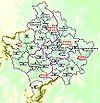 New Municipalities: Đeneral Janković • Gračanica • Junik • Klokot-Vrbovac • Mamuša • Parteš • RanilugPlanned Municipality: North Kosovska Mitrovica
New Municipalities: Đeneral Janković • Gračanica • Junik • Klokot-Vrbovac • Mamuša • Parteš • RanilugPlanned Municipality: North Kosovska MitrovicaHero Cities of the Socialist Federal Republic of Yugoslavia Historical capitals of Serbia 641–950 Destinikon
950–1276 Ras1818–1841 Kragujevac
1849–1860 Temišvar
1914–1915 Kragujevac
1915 Nišsince 1841 BelgradeCategories:- Hero Cities of the Socialist Federal Republic of Yugoslavia
- Former capitals of Serbia
- Pristina
- Capitals in Europe
- Populated places in Kosovo
- Gegëri
- Municipalities of Kosovo
Wikimedia Foundation. 2010.

